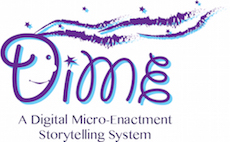Enactment-Based Storytelling
Background
The DiME project investigates the use of embodied enactment to support children's creative thinking and creative self-efficacy in storytelling. We target children aged 8 to 11, as they undergo a period often referred to as the 'fourth-grade slump'. DiME has resulted in a prototype that enables children to create stories through body enactment and the use of physical objects in a motion-tracking system setup. The system is based in the core concept of performative authoring. The main mechanisms by which performative authoring functions are the following:
- Body enactment and the support of physical objects allow the child to draw from his or her embodied prior experiences to bring forth story ideas.
- Story ideas are expressed in a form:
- ...in which the child is fluent, i.e., body actions, thereby decoupling the technical skills of storytelling from idea generation.
- ...that is of interest to the child, in our case, in the form of animated cartoons.
- ...that allows the child to de-identify herself from her inadequacies in expression, without a sense of authorial empowerment and satisfaction.
Activity
- We are currently investigating the development of low-cost solutions to the implementation of DiME through the Kinect and other tracking devices.
- We are also currently studying how gestures help children to scaffold creativity in collaborative storytelling scenarios.
Project Team Members
- Maricela Mirelez (Undergraduate student, Psychology)
- Kumar Sridharamurthy (MS student, Visualization)
- Nazif Ali (Undergraduate student, Computer Science)
- Dr. Sharon Lynn Chu (Assistant Professor, Visualization)
- Dr. Francis Quek (Professor, Visualization)
Related Publications
- Chu, S., Quek, F. and Sridharamurthy, K. (2015). Augmenting Children’s Creative Self-Efficacy and Performance through Enactment-Based Animated Storytelling. In Proceedings of the 9th International Conference on Tangible, Embedded and Embodied Interaction (TEI'15). Stanford University, CA. ACM.
- Chu, S. and Quek, F. (2014). Exploring Performative Authoring as a Story Creation Approach for Children. In Proceedings of International Conference on Interactive Digital Storytelling (ICIDS ’14). Singapore, Singapore.
- Chu, S., Quek, F. and Sridharamurthy, K. (2014). Ready...Action! A Performative Authoring System for Children to Create Animated Stories. In Proceedings of the 11th Advances in Computer Entertainment Technology Conference (ACE ’14). Madeira, Portugal.
- Chu, S. and Quek, F. (2014). The Effects of Visual Contextual Structures on Children’s Imagination in Story Authoring Interfaces. In Proceedings of Interaction Design & Children (IDC ’14). Aarhus, Denmark.
- Chu, S., Quek, F. and Tanenbaum, J. (2013). Performative Authoring: Nurturing Storytelling in Children through Imaginative Enactment. In Proceedings of the International Conference on Interactive Digital Storytelling (ICIDS ’13). Istanbul, Turkey. [Best Paper Award]
- Chu, S. and Quek, F. (2013). Things to Imagine With: Designing For the Child's Creativity. In Proceedings of Interaction Design & Children '13. New York City, NY: ACM.
- Chu, S., Quek, F., Gusukuma, L. and Tanenbaum. J. (2013). The Effects of Physicality on the Child's Imagination. In Proceedings of Creativity and Cognition '13. Sydney: Australia.
- Chu, S., Quek, F. and Lin, X. (2011) Studying Medium Effects on Children's Creative Processes. In Creativity & Cognition ‘11. ACM: pp. 3-12: Atlanta, GA.
